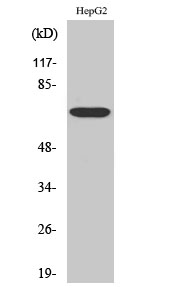Follistatin Polyclonal Antibody
- SPECIFICATION
- CITATIONS
- PROTOCOLS
- BACKGROUND

Application
| WB, IHC-P |
|---|---|
| Primary Accession | P19883 |
| Reactivity | Human, Mouse, Rat |
| Host | Rabbit |
| Clonality | Polyclonal |
| Calculated MW | 38007 Da |
| Gene ID | 10468 |
|---|---|
| Other Names | FST; Follistatin; FS; Activin-binding protein |
| Dilution | WB~~Western Blot: 1/500 - 1/2000. Immunohistochemistry: 1/100 - 1/300. ELISA: 1/5000. Not yet tested in other applications. IHC-P~~N/A |
| Format | Liquid in PBS containing 50% glycerol, 0.5% BSA and 0.09% (W/V) sodium azide. |
| Storage Conditions | -20℃ |
| Name | FST (HGNC:3971) |
|---|---|
| Function | Multifunctional regulatory protein whose primary function is to antagonize members of the transforming growth factor beta (TGF-beta) superfamily including activin, myostatin, GDF11 or bone morphogenetic proteins (BMPs) (PubMed:11279126, PubMed:16482217, PubMed:18535106). Mechanistically, binds to these ligands in the extracellular space, blocking their type II receptor-binding site to inhibit downstream signaling (PubMed:16482217). Plays an essential role in muscle fiber formation and growth both by preventing the repressive effects of myostatin and through SMAD3/AKT/mTOR signaling independently of myostatin (By similarity). Also promotes neural differentiation by antagonizing the action BMP4 (By similarity). Acts as a specific inhibitor of the biosynthesis and secretion of pituitary follicle stimulating hormone (FSH) by sequestering activin A/INHBA (PubMed:11279126). On the other hand, translocates into the nucleus where it down-regulates rRNA synthesis and ribosome biogenesis to maintain cellular energy homeostasis by binding to rDNA. |
| Cellular Location | Secreted. Nucleus, nucleolus |
| Tissue Location | Isoform 1 is the predominant isoform in serum but is undetectable in follicular fluid. In the embryo, strong expression is seen in the palatal epithelia, including the medial edge epithelial and midline epithelial seam of the palatal shelves. Less pronounced expression is also seen throughout the palatal shelf and tongue mesenchyme (PubMed:31215115). |

Thousands of laboratories across the world have published research that depended on the performance of antibodies from Abcepta to advance their research. Check out links to articles that cite our products in major peer-reviewed journals, organized by research category.
info@abcepta.com, and receive a free "I Love Antibodies" mug.
Provided below are standard protocols that you may find useful for product applications.
Background
Binds directly to activin and functions as an activin antagonist. Specific inhibitor of the biosynthesis and secretion of pituitary follicle stimulating hormone (FSH).
If you have used an Abcepta product and would like to share how it has performed, please click on the "Submit Review" button and provide the requested information. Our staff will examine and post your review and contact you if needed.
If you have any additional inquiries please email technical services at tech@abcepta.com.













 Foundational characteristics of cancer include proliferation, angiogenesis, migration, evasion of apoptosis, and cellular immortality. Find key markers for these cellular processes and antibodies to detect them.
Foundational characteristics of cancer include proliferation, angiogenesis, migration, evasion of apoptosis, and cellular immortality. Find key markers for these cellular processes and antibodies to detect them. The SUMOplot™ Analysis Program predicts and scores sumoylation sites in your protein. SUMOylation is a post-translational modification involved in various cellular processes, such as nuclear-cytosolic transport, transcriptional regulation, apoptosis, protein stability, response to stress, and progression through the cell cycle.
The SUMOplot™ Analysis Program predicts and scores sumoylation sites in your protein. SUMOylation is a post-translational modification involved in various cellular processes, such as nuclear-cytosolic transport, transcriptional regulation, apoptosis, protein stability, response to stress, and progression through the cell cycle. The Autophagy Receptor Motif Plotter predicts and scores autophagy receptor binding sites in your protein. Identifying proteins connected to this pathway is critical to understanding the role of autophagy in physiological as well as pathological processes such as development, differentiation, neurodegenerative diseases, stress, infection, and cancer.
The Autophagy Receptor Motif Plotter predicts and scores autophagy receptor binding sites in your protein. Identifying proteins connected to this pathway is critical to understanding the role of autophagy in physiological as well as pathological processes such as development, differentiation, neurodegenerative diseases, stress, infection, and cancer.


